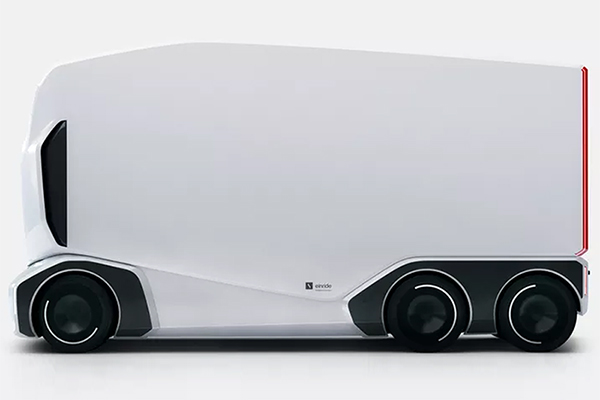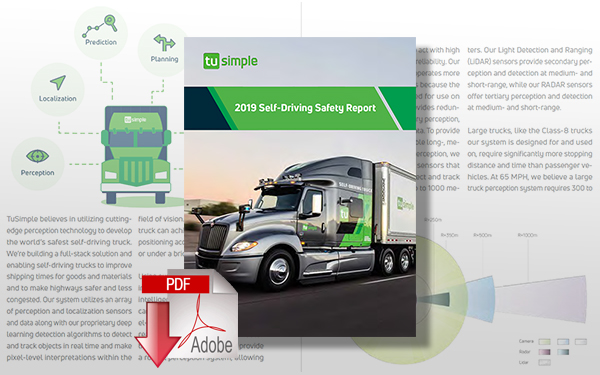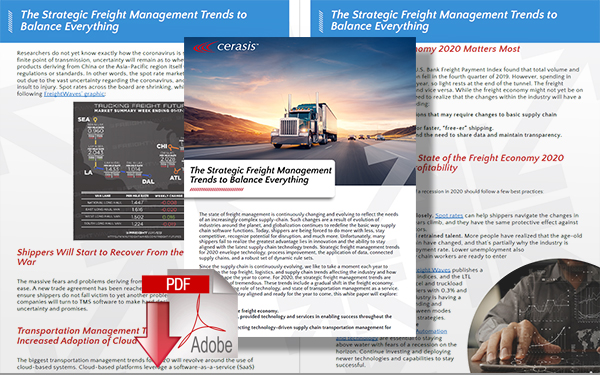Autonomous Trucking
Freight mobility leader Einride launched the next generation of its groundbreaking Pod, with new functionality and pricing, making it commercially available on a global scale for the first time.
As reported by The Verge, the Swedish autonomous trucking startup, unveiled a new vehicle type that the company hopes to have on the road delivering freight starting in 2021.
The vehicles, dubbed Autonomous Electric Transport (AET), came in four different variations.
And much like Einride’s previous prototypes, they come without steering wheels, pedals, windshields, and, in general, no cab at all.
Einride - Autonomous Trucking Startup
Einride has been in the business of releasing interesting, eye-catching prototype vehicles since it was founded in 2016.
There was the cab-less T-Pod, released in 2017, four of which are operating on public roads hauling freight for Oatly, the Swedish food producer.
A year later, the company unveiled the T-Log, built to be more powerful than its predecessor for the job of hauling tons of giant tree logs.
Now it has a next-generation vehicle that it hopes it can put into production.
Einride’s also been engaged with the less glamorous part of the job, which is testing, validating, and seeking regulatory approval for its vehicles, all of which are electric and can be controlled remotely by a human operator, in addition to operating autonomously without human intervention. The company has yet to reveal its plans for production and manufacturing.
Raises $10 Million to Fast Track Its Autonomous Electric Cargo Pods
A year after elevating $25 million, the corporate stated it has one other $10 million coming in from its current traders.
The announcement comes forward of a brand new automobile that Einride unveiled yesterday, October 8, 2020 (see video above).
Not a lot is understood in regards to the automobile; Einride has solely provided a brief and obscure teaser video.
Einride stated the $10 million in new funding was led by impression fund Norrsken VC and included participation from EQT Ventures fund, Nordic Ninja VC, and Ericsson Ventures. Norrsken VC can also be becoming a member of Einride’s advisory board.
The capital will likely be used to quickly monitor the official launch of its Einride Pods, the corporate stated. Einride acknowledged that startups in AI and robotics had been upended, and even shuttered altogether, within the early days of the COVID-19 pandemic. The corporate contests that demand contactless supply choices - not coincidentally the type it hopes to offer - has grown due to COVID-19.
Einride stated it’s maintained a “sturdy stream of recent partnerships,” together with onboarding companions Oatly and grocery store chain Lidl in addition to launching a freight mobility platform designed to present prospects data on delivery quantity, distance pushed, and related emissions and assist choose probably the most environment-friendly routes.
“There may be each a number of pleasure and a number of uncertainties about autonomous trucking, however, the reality stays: this is, without doubt, one of the largest enterprise alternatives within the historical past of mankind,” stated Einride CEO Robert Falck in a press release, who added that the corporate expects to see the autonomous transport trade increase exponentially within the coming years, particularly within the wake of a world pandemic.
Self-Driving Vehicles: What Will Happen to Truck Drivers?
The replacement of drivers will be one of the most dramatic, visible battlegrounds between automation and the human worker.
Andrew Yang, in his editorial article for evonomics, stated that driving a truck is the most popular job in 29 states – there are 3.5 million truck drivers nationwide.
Trucks that drive themselves are already rolling out around the world. Self-driving trucks successfully made deliveries in Nevada and Colorado in 2017. Rio Tinto has 73 autonomous mining trucks hauling iron ore 24 hours a day in Australia. Europe saw its first convoys of self-driving trucks cross the continent in 2016. In 2016 Uber bought the self-driving truck company, Otto, for $680 million and now employs 500 engineers to perfect the technology. Google spun off its self-driving car company Waymo, which is working on self-driving trucks with the big truck manufacturers Daimler and Volvo.
Switching to automated drivers will not only save billions, but it also has the potential to save thousands of lives. Crashes involving large trucks killed 3,903 people in the US in 2014, according to the National Highway Traffic Safety Administration, and a further 110,000 people were injured. More than 90% of the accidents were caused at least in part by driver error. Driver fatigue is a factor in roughly one out of seven fatal accidents. Most of us when we were taught to drive growing up were told to avoid trucks on the highway. There’s a reason for that.
So the incentives to adopt automated truck driving are massive – tens of billions of dollars saved annually plus thousands of lives. They are so large that one could argue it is important for national competitiveness and human welfare that this happens as quickly as possible. Adding to the incentives is that many freight companies report labor shortages because they can’t find enough people willing to take on the physically demanding and punishing job of spending hundreds of hours sitting in a confined space.
Truck drivers spend 240 nights per year away from home staying in truckstops and motels and 11 hours per day on the road. Obesity, diabetes, smoking, inactivity, and high blood pressure are common, with one study saying 88 percent of drivers had at least one risk factor for chronic disease.
Many, however, will argue for the preservation of truck driving because they recognize just how problematic it would be for such a large number of uneducated male workers to be displaced quickly.
Taking even a fraction of the 3.5 million truckers off the road will have ripple effects far and wide. It is impossible to overstate the importance of truck drivers to regional economies around the country. As many as 5.2 million workers serve the needs of truck drivers at truck stops, diners, motels, and other businesses around the country. Over 2,000 truck stops around the country serve as dedicated hotels, restaurants, grocery stores, and entertainment hubs for truckers every day. If one assumes that each trucker spends only $5k a year on consumption on the road (about $100 per week), that’s a $17.5 billion economic hit in communities around the country. Beyond the hundreds of thousands of additional job losses, many communities may risk losing a sense of purpose without thousands of truckers coming through each day. For example, in Nebraska, one out of every 12 workers – 63,000 workers – works in and supports the trucking industry.
Truck drivers do not see it coming. Indeed, when Bloomberg’s Shift Commission in 2017 asked truck drivers about how concerned they were about their jobs being replaced by automation, they almost uniformly weren’t concerned at all. Let me assure you it's coming. Elon Musk recently announced that Tesla will be debuting a freight truck in late 2017. Elon also proclaimed that by 2019, all new Teslas will be self-driving. “Your car will drop you off at work, and then it will pick other people up and make you money all day until it’s time to pick you up again,” Musk proclaimed. ”This will 100% happen.”
It is obvious that Tesla trucks will eventually have the same self-driving capabilities as their cars. Other autonomous vehicle companies report similar timelines, with 2020 being the first year of mass adoption. And it’s not just those driving trucks who are at risk. A senior official at one of the major ride-sharing companies told me that their internal projections are that half of their rides will be given by autonomous vehicles by 2022. This has the potential to affect about 300,000 Uber and Lyft drivers in the U.S.
Replacing Truck Drivers
The replacement of drivers will be one of the most dramatic, visible battlegrounds between automation and the human worker. Companies can eliminate the jobs of call center workers, retail clerks, fast-food workers, and the like with minimal violence and fuss. Truck drivers will be different.
Right now, the federal government has said that it will allow autonomous vehicles in any states that permit them. One industry report noted that “the [US] Department of Transportation is throwing its full support behind the development of autonomous vehicles as a way to improve safety on our roadways . . ” In 2016 the trucking industry spent $9.1 million on lobbying and the Ohio government has already committed $15 million to set up a 35-mile stretch of highway outside Columbus for testing self-driving trucks. Arizona, California, and Nevada have begun allowing self-driving car trials in their states, and others will follow.
Will truckers and the industry fight back? Back in the 1950s, truckers were highly unionized, with the Teamsters being legendary in their aggressiveness. Today, only about 13% of U.S. truckers are unionized and 90% of the trucking industry is made up of small businesses with ten or fewer trucks. About 10% of truck drivers – 350,000 – are solo owner-operators who own their own trucks; the trucking companies have been pushing drivers to buy or lease their own trucks to reduce overhead.
It will happen in stages. First, there will be automated trucks with a human driver as a failsafe. The technology will allow truckers to go beyond their current 11 hours per day on the road as the driver will be able to rest and do other things during long stretches. This will increase the productivity of trucks and equipment, and likely the reduction in wages of truckers as the pay scale changes. The next stage will have convoys of trucks with the lead truck having a driver and the others following automatically, which lowers wind resistance and fuel costs. There will be docking stations outside urban areas where drivers will enter the trucks for the last 10 miles.
At some point, as the industry becomes more and more automated, truck drivers will realize that the combination of much more efficient trips and lower need for labor will dramatically shrink their total employment. Those that have other options will flee the field. But for many, their opportunities outside of truck driving will be minimal, and they know it. Many are ex-military – about 5% of Gulf War veterans – 80,000 – worked in transportation in 2012. They will be proud and desperate. What might happen when the 350,000 American truckers who bought or leased their own trucks are unemployed and angry? All it takes is one out of 350,000 to lead the others. It doesn’t take a big leap of the imagination to imagine mass protests that could block highways, seize up the economy, and wreak havoc.
No doubt the image of a cab-less truck will further stoke fears that autonomous technology will lead to enormous displacement in the workforce - or just fears about the safety of a tractor-trailer sized vehicle without a human driver. In the US, 4.4 million jobs are related to driving; of those, trucking jobs comprise about 2.5 million. A recent study found that automated trucks could reduce the demand for drivers by as much as 50 to 70 percent in the US and Europe by 2030, with 4.4 million of the 6.4 million professional drivers on both continents rendered obsolete.
The best estimates for when this will unfold are between 2020 and 2030. This starts in two years.
Editorial Note Excerpt from The War on Normal People: The Truth About America’s Disappearing Jobs and Why Universal Basic Income Is Our Future by Andrew Yang, Hachette Books (2018).
Related Article: Amazon Acquires Autonomous Technology Company Zoox
Related Papers
Managing the Transition to Driverless Road Freight Transportation
This report sets out the findings of an ITF project on managing the transition to driverless road freight transport, directed by José Viegas and managed by Daniel Veryard. Download Now!
TuSimple’s Self-Driving Safety Report
This Voluntary Safety Self-Assessment describes TuSimple's safety processes and features as well as the progress they’ve made implementing them. Download Now!
Bringing Long-Haul Electric Trucks into China
This paper addresses two main questions; What are the potential impacts on carbon emissions of electric long haul trucks in China, and what are the barriers to the adoption of electric long haul trucks in China? Download Now!
2020 Strategic Freight Management Trends
In this educational and informative white paper, you will learn about the top freight, logistics, and supply chain trends affecting the industry and how they will shape the year to come. Download Now!
Article topics
Email Sign Up
























